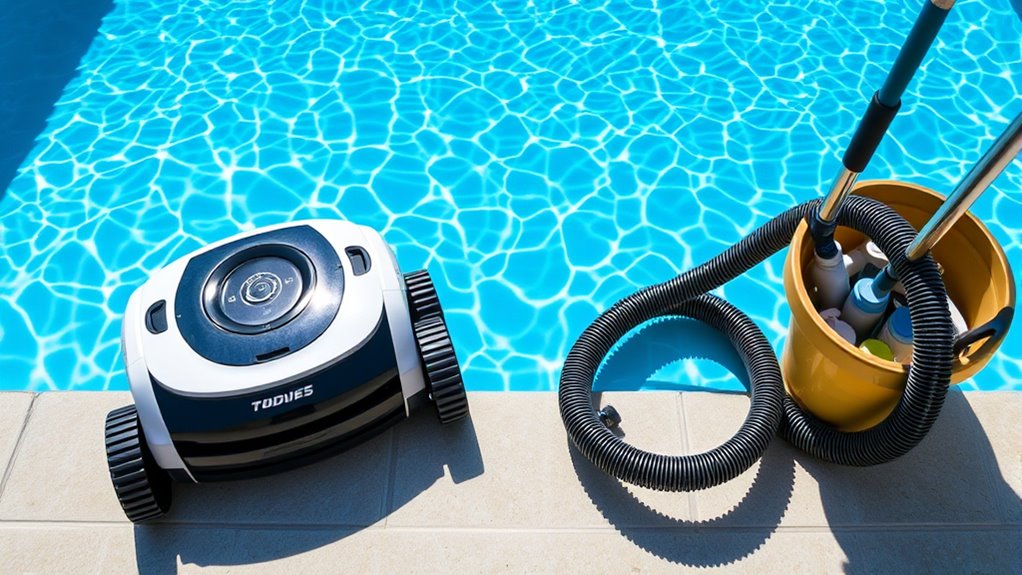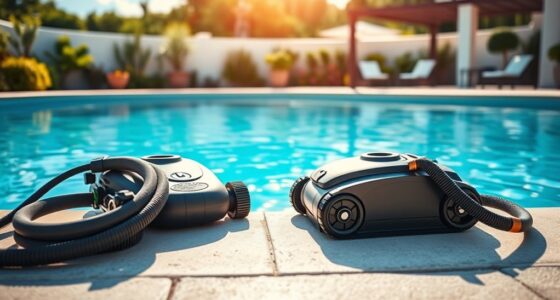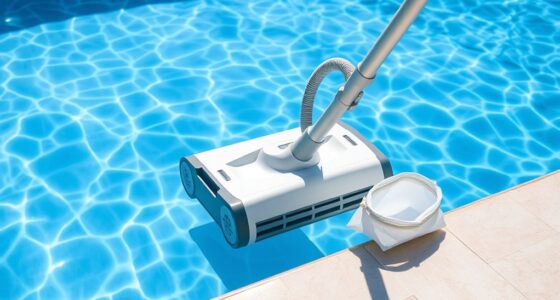Choosing between automatic and manual pool cleaning depends on your budget, pool size, and how much convenience you want. Automatic cleaners save time and provide consistent results but can be expensive and may miss tight spots. Manual cleaning offers more control and is cheaper upfront but demands more effort and time. We’ll help you compare costs, benefits, and drawbacks to find the best fit for your pool, so stick around for all the details.
Key Takeaways
- Automatic cleaners save time and provide consistent cleaning, but have higher upfront costs and limited control over specific areas.
- Manual cleaning offers targeted, thorough results and flexibility but is time-consuming, labor-intensive, and riskier without proper safety measures.
- Automatic devices typically require less ongoing maintenance and chemical handling, whereas manual cleaning needs regular supplies and chemical adjustments.
- Cost-wise, automatic cleaners involve higher initial investment but reduce labor expenses; manual cleaning has lower upfront costs but higher ongoing effort costs.
- The best choice depends on pool size, budget, desired control, time availability, and long-term maintenance preferences.
Overview of Pool Cleaning Methods
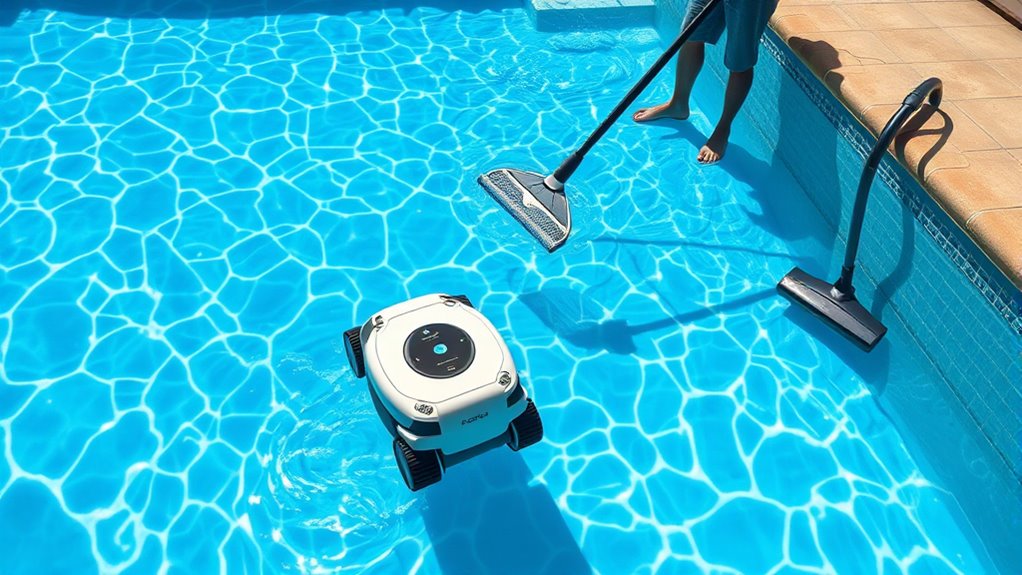
When it comes to keeping your pool clean, there are two main approaches: automatic and manual cleaning methods. Manual cleaning involves scrubbing the pool surface, skimming debris, and using a hose or pole to remove dirt. This method relies heavily on your effort and time. To maintain water quality, you’ll need to regularly add pool chemicals and monitor pH levels, ensuring the water stays safe and balanced. Water filtration systems also play a crucial role, as they continuously circulate and filter the water to remove dirt, debris, and contaminants. Automatic cleaning methods, like robotic cleaners, handle much of this process for you, but manual cleaning gives you more control over cleaning frequency and thoroughness. Both approaches aim to keep your pool clear, hygienic, and inviting. Additionally, regular maintenance of the filter system is essential for optimal performance and water clarity. routine inspections can help identify issues early and prevent costly repairs, ensuring your pool remains in top condition year-round. Regularly checking your pool’s cleaning equipment will help maintain its efficiency and extend its lifespan. Moreover, choosing the right water spot remover can improve the appearance of your pool surface, especially after heavy rains or storms. Maintaining your pool equipment properly, including cleaning and lubrication, can also prevent breakdowns and ensure consistent operation.
Advantages of Automatic Pool Cleaners
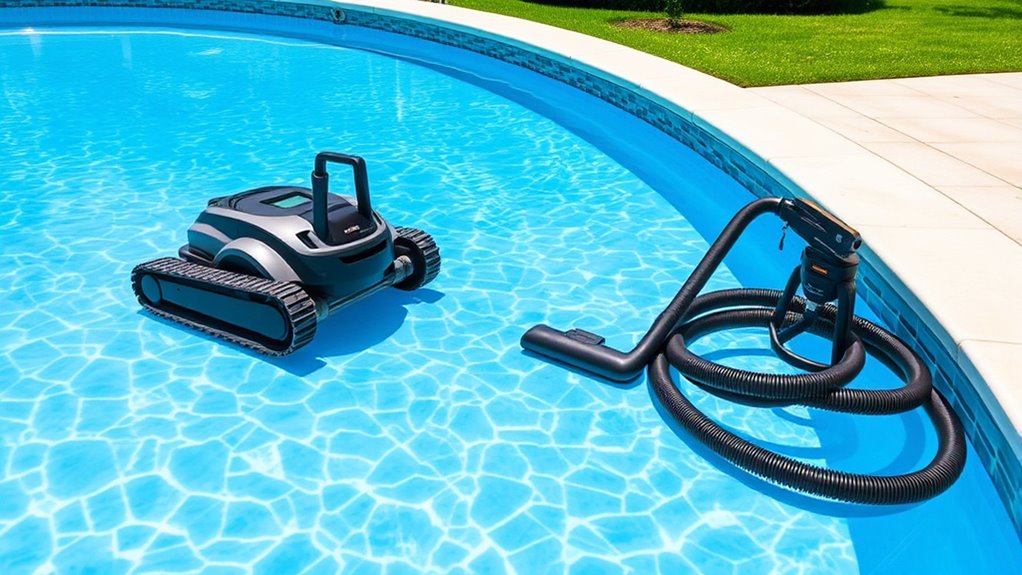
Automatic pool cleaners save you time by handling routine cleaning without your intervention. They also provide consistent results, keeping your pool spotless and balanced. With these benefits, you can enjoy a cleaner pool with less effort on your part. Incorporating multi-functional furniture in your poolside area can further enhance your space’s versatility and organization. Additionally, choosing the right type of automatic cleaner can depend on local regulations and your specific pool size, ensuring optimal performance and compliance. Considering Mazda Tuning techniques, such as performance upgrades and aesthetic enhancements, can also improve your overall poolside experience by making your outdoor space more enjoyable and personalized. Proper maintenance of your automatic cleaner, including regular inspection and cleaning of parts like nozzle tips and filters, ensures long-lasting performance and optimal cleaning results. Regularly checking and maintaining filter systems helps sustain the cleaner’s efficiency over time.
Time-Saving Efficiency
Because they operate independently, automatic pool cleaners save you significant time and effort compared to manual cleaning. With their robotic efficiency, they navigate your pool, scrubbing surfaces and collecting debris without your intervention. Unlike manual timing, which requires you to allocate specific periods for cleaning, automatic cleaners work on pre-set schedules, freeing up your day. This means you spend less time maintaining your pool and more enjoying it. Additionally, maintenance needs are typically lower with automatic cleaners, reducing ongoing costs and effort. Proper filter management ensures optimal performance and extends the lifespan of your cleaner, making maintenance even more straightforward. Modern automatic cleaners often incorporate advanced navigation technology, allowing them to cover the entire pool surface more effectively. For optimal results, understanding automatic cleaner features can help you select the best model for your pool’s size and shape. Here’s a quick comparison:
| Feature | Manual Cleaning | Automatic Cleaner |
|---|---|---|
| Time Investment | High | Low |
| Effort | Intensive | Minimal |
| Scheduling | Manual | Automated |
| Consistency | Variable | Consistent |
| Convenience | Low | High |
Switching to automatic cleaners maximizes your time savings while ensuring your pool stays pristine effortlessly. Kia Tuning can improve your vehicle’s performance, but for your pool, choosing an automatic cleaner offers unmatched ease and efficiency.
Consistent Cleaning Results
While manual cleaners rely on your oversight to maintain consistency, automatic pool cleaners deliver uniform results every time they run. They ensure your pool stays clean, which helps keep chlorine levels balanced and prevents algae buildup. By consistently removing debris, automatic cleaners reduce the risk of cloudy water and uneven distribution of chemicals. This consistency also benefits your pool lighting, preventing dirt or algae from dimming its clarity. With automatic cleaners, you don’t have to worry about missed spots or uneven cleaning, giving you peace of mind that your entire pool receives thorough coverage. This reliability means less manual intervention and more predictable, professional-quality results, keeping your pool sparkling and safe with minimal effort. Additionally, automatic pool cleaners often incorporate advanced navigation technology, ensuring comprehensive coverage and reducing the need for manual intervention. Furthermore, the use of advanced technology can optimize cleaning patterns and improve efficiency over time, making the entire process more efficient and reliable, especially when combined with consistent cleaning results. Implementing sensor technology can further enhance the precision of cleaning paths, adapting to different pool shapes and obstacles to ensure thorough cleaning.
Drawbacks of Automatic Pool Cleaners
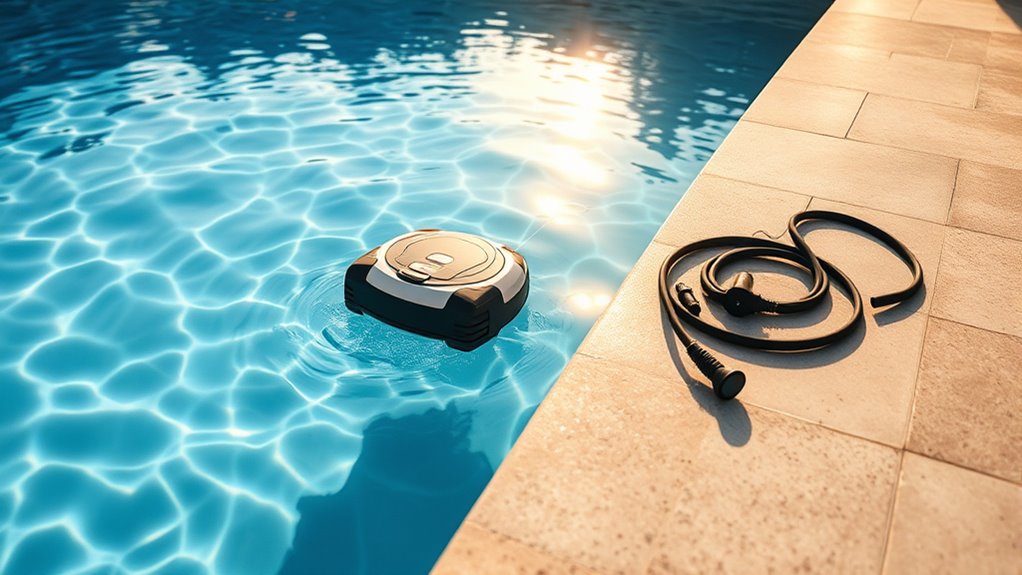
Despite their convenience, automatic pool cleaners come with certain drawbacks that can impact their effectiveness and overall value. One major concern is their energy consumption, which can lead to higher electricity bills over time. These devices often run for hours, increasing your environmental impact through increased energy use. Additionally, some models may not clean as thoroughly as manual methods, especially in corners or tight spaces, leaving debris behind. They can also be prone to breakdowns or malfunctions, leading to repair costs. Moreover, their reliance on batteries or power cords can limit mobility and ease of use. Overall, while automatic cleaners save time, these drawbacks are important considerations when evaluating whether they truly meet your cleaning needs and budget in the long run.
Benefits of Manual Pool Cleaning
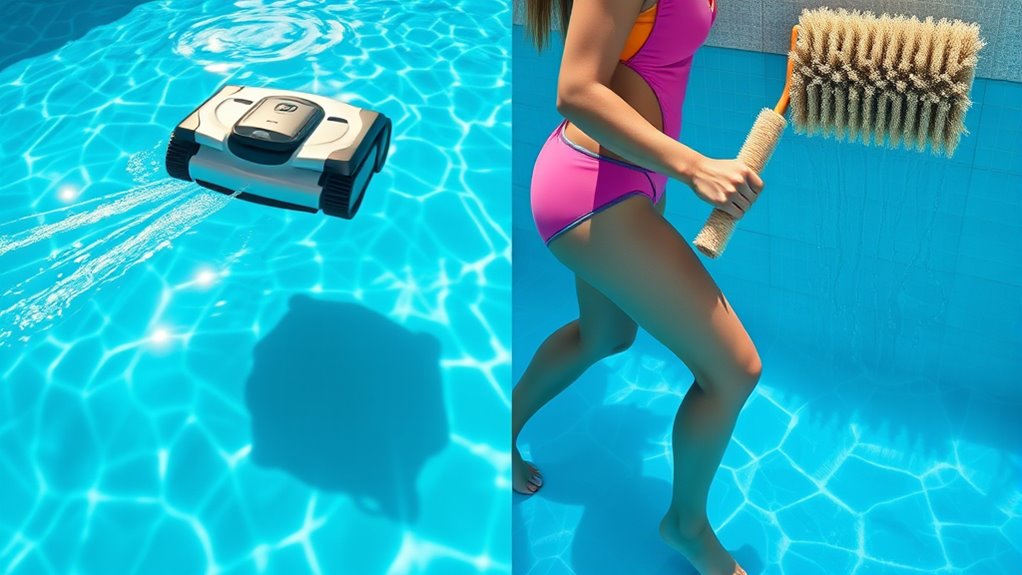
Manual pool cleaning gives you greater control over how your pool is cleaned, allowing you to focus on problem areas. You can target specific debris and stains that automatic cleaners might miss, ensuring a thorough job. Plus, it provides a bit of physical activity, helping you stay active while maintaining your pool.
Greater Cleaning Control
Manual pool cleaning gives you greater control over the cleanliness of your pool because you can target specific areas that automated systems might miss. This is especially helpful for pools with unique shapes or cluttered corners. You determine the cleaning frequency based on your pool’s size and usage, ensuring it stays spotless without over-cleaning. You can focus on stubborn spots or debris buildup, maintaining a higher level of hygiene.
Think about:
- Reaching tight corners and edges
- Removing debris from stairs or ledges
- Addressing algae or stains promptly
- Adjusting cleaning based on weather or pool use
- Managing delicate pool features carefully
This level of control allows you to tailor cleaning routines precisely to your pool’s needs, keeping it cleaner and healthier.
Targeted Debris Removal
Have you noticed debris accumulating in specific areas of your pool? Manual cleaning allows you to target these spots precisely, making leaf pickup and algae removal more effective. You can focus on problem zones like corners or steps, ensuring no debris is missed. This targeted approach prevents algae buildup and keeps your pool consistently clear. Use tools like skimmers or brushes to focus on areas prone to debris accumulation.
| Area | Debris Type | Action Needed |
|---|---|---|
| Pool corners | Leaves, dirt | Precise leaf pickup |
| Floor | Small debris | Focused vacuuming |
| Walls | Algae | Targeted algae removal |
| Steps/Rails | Stagnant debris | Spot cleaning |
Manual cleaning gives you control, ensuring your pool stays pristine.
Physical Exercise Benefits
Engaging in pool cleaning can provide notable physical exercise benefits, turning a routine chore into an effective workout. As you scrub and skim, you’re engaging muscles and improving your swimming stamina through constant movement and water resistance. Manual cleaning keeps you active, helping burn calories while strengthening your arms, shoulders, and core. It also boosts cardiovascular health as you move around the pool area.
Consider these benefits:
- Enhances swimming stamina through repetitive motion
- Strengthens muscles by fighting water resistance
- Improves flexibility with varied movements
- Burns calories, aiding weight management
- Promotes overall fitness with consistent activity
Challenges of Manual Pool Cleaning
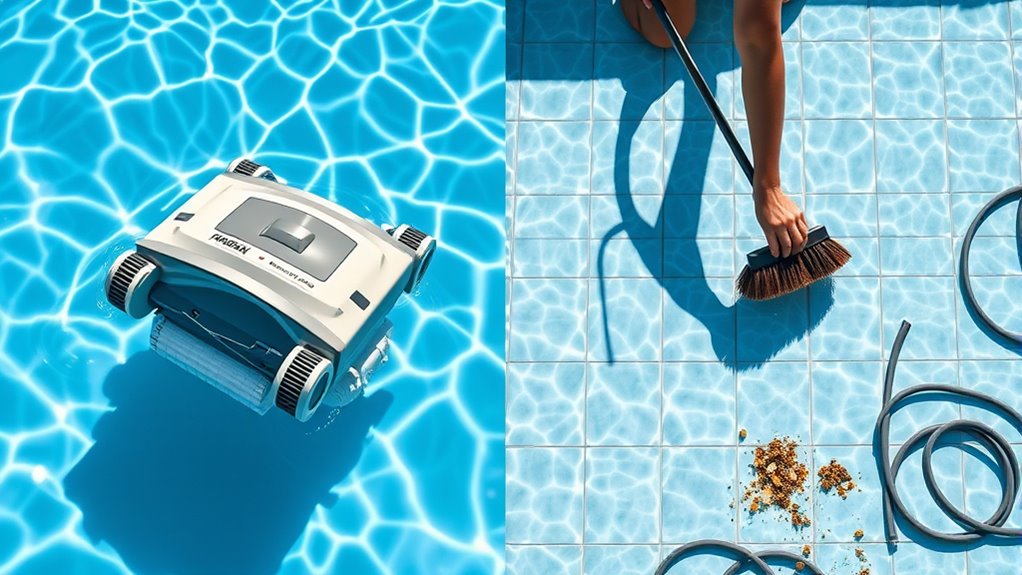
Despite its common use, manual pool cleaning often presents several challenges that can make the task time-consuming and frustrating. You need to carefully handle pool chemicals, following strict pool safety protocols to avoid accidents or skin irritation. Maintaining proper chemical balance requires constant attention, which can be overwhelming if you’re unfamiliar with the process. Additionally, manual cleaning demands physical effort, especially when scrubbing surfaces or vacuuming debris from hard-to-reach spots. It’s easy to miss areas, leading to uneven cleanliness and potential algae growth. The process also exposes you to risks like slipping or chemical exposure if safety procedures aren’t strictly followed. Overall, manual cleaning demands patience, knowledge, and physical stamina—factors that can make it less appealing compared to automated solutions.
Cost Analysis of Both Cleaning Options
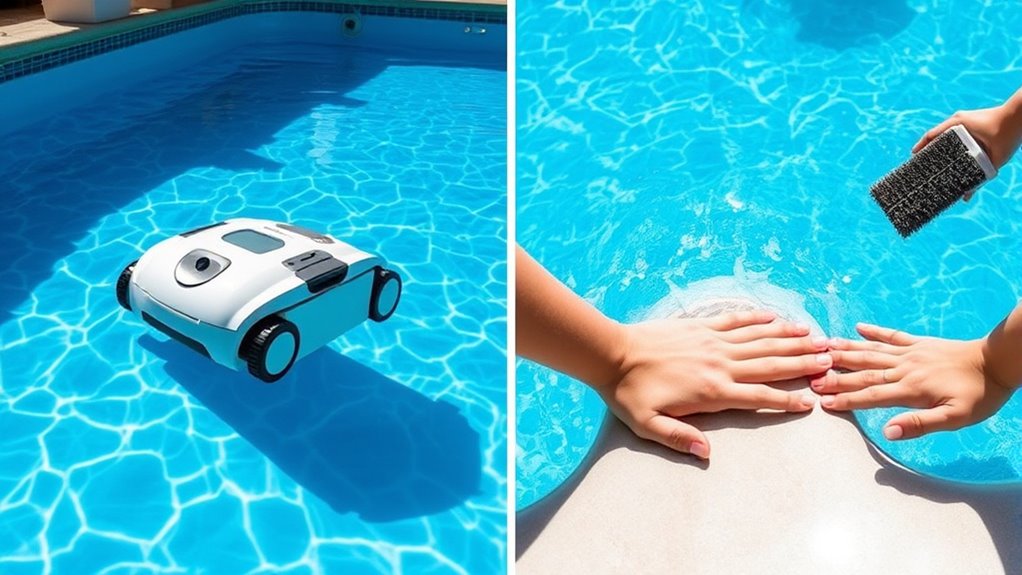
When comparing the costs of manual and automatic pool cleaning, it’s important to contemplate both initial investments and ongoing expenses. Manual cleaning requires minimal upfront costs but can add up over time with supplies and labor. Automatic cleaners, on the other hand, usually involve a higher initial purchase but often reduce long-term labor costs. Your budget considerations should include:
- Purchase price of robotic or automatic cleaners
- Maintenance and replacement parts
- Regular cleaning supplies for manual methods
- Electricity costs for automated devices
- Time and labor savings
This cost comparison helps you decide which option fits your financial plan while maintaining your pool effectively. Balancing upfront costs with long-term expenses ensures you choose a cleaning method that aligns with your budget considerations.
Factors to Consider When Choosing a Method
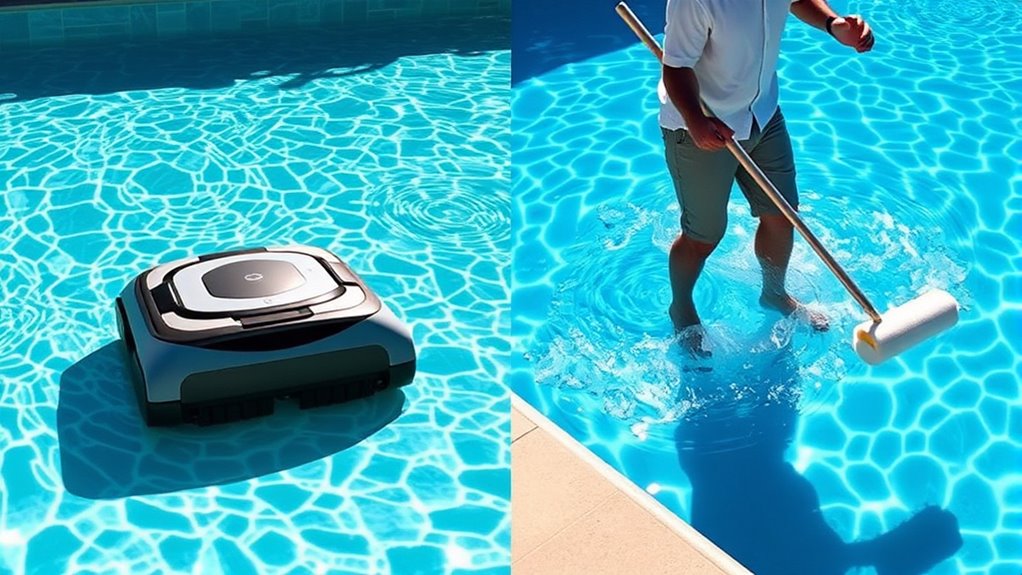
Choosing the right pool cleaning method depends on several key factors that match your specific needs and circumstances. Your pool size plays a significant role—larger pools may benefit from automatic cleaners for efficiency, while smaller pools might be easier to manage manually. User preference also matters; if you prefer hands-on control and enjoy routine tasks, manual cleaning could suit you better. Conversely, if you want convenience and minimal effort, an automatic system might be the better choice. Consider how much time you’re willing to dedicate to maintenance and your comfort level with technology. Additionally, your budget and long-term maintenance expectations influence your decision. Ultimately, balancing these factors helps you select the most suitable pool cleaning method for your lifestyle.
Maintenance and Durability Aspects
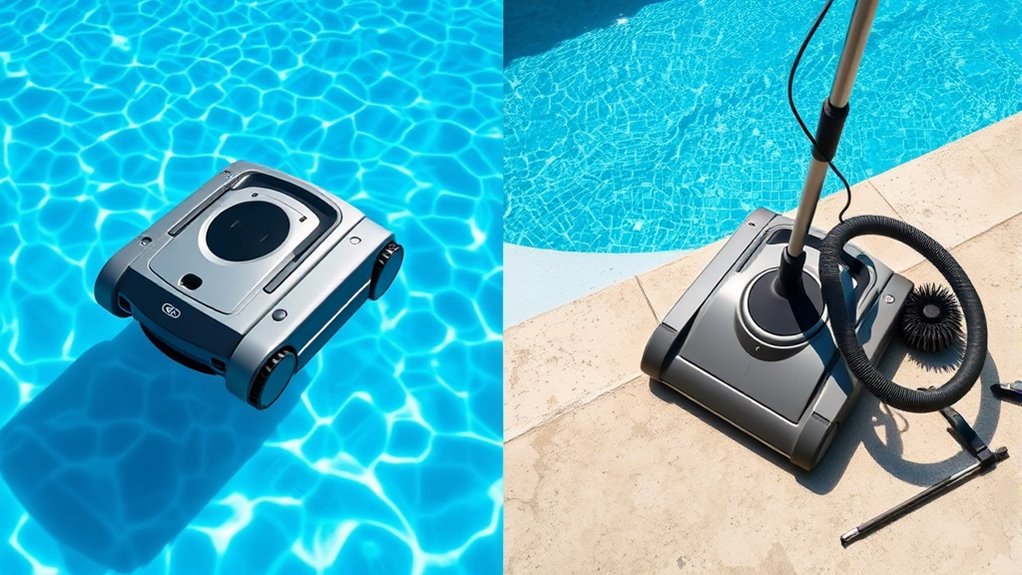
Your choice of pool cleaning method directly impacts how much time and effort you’ll spend on maintenance and how long your equipment will last. Automatic cleaners often require less frequent manual intervention, reducing chemical maintenance since they keep debris off surfaces and maintain water quality. They tend to have higher equipment durability due to fewer moving parts or better quality materials. Manual cleaning, however, demands regular scrubbing, skimming, and chemical adjustments, which can lead to quicker wear and tear if not done properly. Consider these factors:
- Automatic cleaners typically require less frequent maintenance
- Manual cleaning involves consistent chemical adjustments
- Equipment durability varies with build quality
- Automatic devices often have longer lifespans
- Proper maintenance extends equipment longevity, regardless of method
Choosing wisely influences both your pool’s upkeep and the longevity of your cleaning tools.
Making the Right Choice for Your Pool
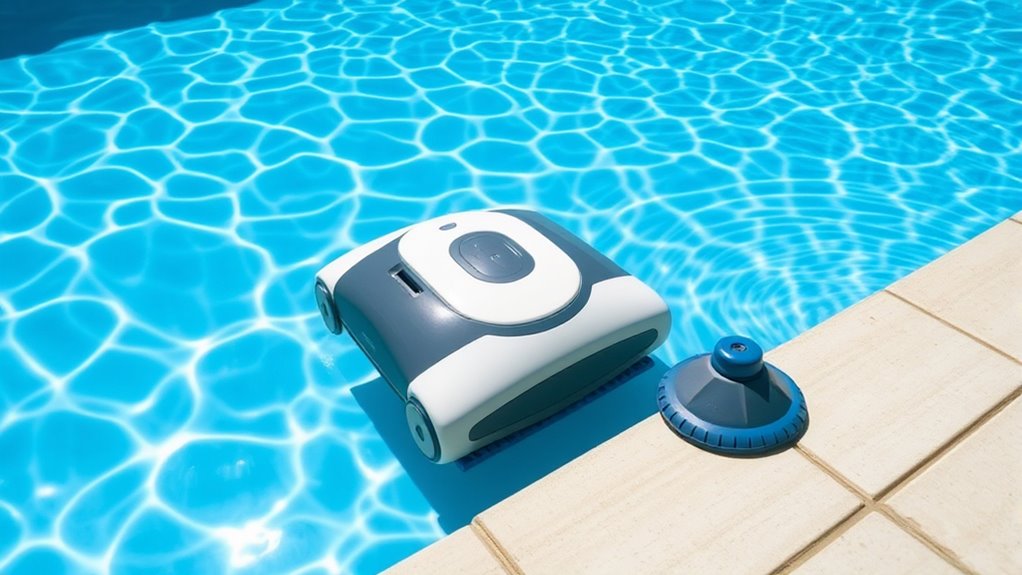
Deciding between automatic and manual pool cleaning depends on your specific needs, budget, and lifestyle. If you want convenience and save time, an automatic cleaner may suit you, especially since many models are energy efficient and minimize your environmental impact. Automatic cleaners typically use less energy, making them more eco-friendly over time. However, they require an upfront investment and regular maintenance. Manual cleaning offers control, lower initial costs, and the ability to target specific areas, but it can be more labor-intensive and less energy efficient. Consider your pool size, frequency of use, and environmental priorities. Choosing the right option involves balancing convenience, cost, and eco-consciousness to ensure your pool stays clean while aligning with your values.
Frequently Asked Questions
How Often Should Each Cleaning Method Be Used?
You should clean your pool regularly to maintain proper chemical balance and filtration system efficiency. For manual cleaning, aim for weekly brushing and skimming to remove debris and prevent algae buildup. Automatic cleaners work best with a consistent schedule, such as every few days or weekly, depending on pool usage. Regular cleaning helps keep the water clear, balanced, and safe, reducing the need for chemical adjustments and ensuring your filtration system functions *efficiently*.
Can Manual Cleaners Reach All Pool Areas Effectively?
Manual cleaners can reach all pool areas effectively because you control their movement, allowing for manual precision. While robotic efficiency is impressive, manual cleaning lets you target tricky spots and corners that automated systems might miss. With proper technique, you guarantee thorough coverage, making manual cleaning a reliable choice for exhaustive pool maintenance. Your hands-on approach provides the flexibility needed to keep every inch of your pool spotless.
Are Automatic Cleaners Suitable for All Pool Shapes?
Think of your pool as a unique canvas, each shape demanding its own touch. Automatic cleaners are like skilled artists, adapting well to standard shapes for thorough cleaning coverage. However, when it comes to complex or irregular pool shapes, they might miss some corners or tight spots. So, if your pool has a quirky shape, manual cleaning or specialized equipment might be better to guarantee every nook and cranny gets spotless.
What Safety Concerns Are Associated With Automatic Cleaners?
When considering robotic safety, you should be aware of potential electrical hazards associated with automatic cleaners. Make certain the device is properly grounded and complies with safety standards to avoid electrical shocks. Regularly inspect cords and connections for damage, and keep the unit dry when not in use. By following these precautions, you can enjoy the convenience of robotic pool cleaners while minimizing safety risks.
How Do Seasonal Changes Affect Cleaning Method Efficiency?
Seasonal changes considerably impact your pool cleaning method efficiency. During seasonal maintenance, you’ll notice climate impacts like falling leaves or algae growth, which make automatic cleaners more effective in debris removal. In colder months, manual cleaning might be preferable since automatic systems can struggle with debris or freezing conditions. Adjust your cleaning approach based on climate impacts and seasonal maintenance needs to keep your pool in ideal condition year-round.
Conclusion
Choosing between automatic and manual pool cleaning depends on your budget, pool size, and maintenance preferences. Did you know that automatic cleaners can cut cleaning time by up to 50%? Considering the pros, cons, and costs, you can make an informed decision that keeps your pool sparkling without overwhelming your schedule. Whatever you choose, regular maintenance guarantees your pool stays inviting and in top shape for years to come.

